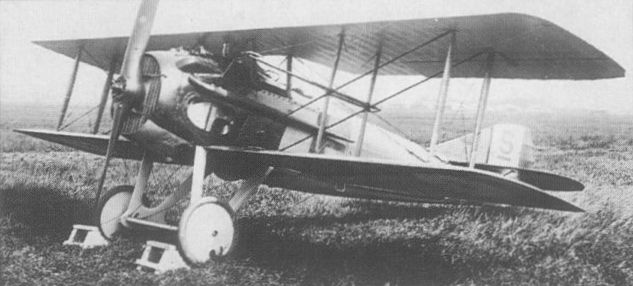W.Green, G.Swanborough The Complete Book of Fighters
SPAD S.XVII France
Essentially a strengthened S.XIII airframe with a 300 hp Hispano-Suiza 8Fb engine, the S.XVII had the same overall dimensions as the earlier fighter, but the fuselage was bulkier and fully faired throughout its length, the stringers being set closer together. The wing structure was substantially strengthened, a visible reinforcement being the auxiliary flying wires under the lower wings. Late in 1917, the 300 hp engine had been installed in an S.XIII airframe, presumably as a prototype for the S.XVII, but this had crashed early in its test programme. Subsequent production apparently did not extend beyond the 20 aircraft of what may be assumed to have been an initial development batch. Operational trials with the S.XVII were performed in June 1918, and examples were flown by pilots of Les Cicognes.
Max speed, 135 mph (217 km/h) at 6,560 ft (2 000 m).
Time to 6,560 ft (2000 m), 5.4 min.
Endurance, 1.25 hrs.
Empty weight, 1,411 lb (640 kg).
Loaded weight, 1,984 lb (900 kg).
Span, 26 ft 6 in (8,08 m).
Length, 20 ft 6 in (6,25 m).
Height, 8 ft 6 1/2 in (2,60 m).
Wing area, 215.28 sqft (20,00 m2).
SPAD S.XXI France
Virtually contemporary with and very similar to the S.XVII, the S.XXI single-seat fighter was powered by the 300 hp Hispano-Suiza 8Fb engine and carried an armament of twin 7,7-mm Vickers guns. The fuselage and tail unit of the S.XXI were fundamentally similar to those of the S.XVII, but whereas the latter had ailerons on the upper wing only, the S.XXI had ailerons on both upper and lower surfaces of slightly extended, equi-span wings. Test flying of the S.XXI had been concluded by October 1918, and the type was abandoned for operational purposes in the following month. Two S.XXIs were briefly retained for experimental purposes after World War I terminated.
Max speed, 137 mph (221 km/h) at 6,560 ft (2000 m).
Time to 6,560 ft (2 000 m), 5.67 min.
Endurance, 1.67 hrs.
Span, 27 ft 7 1/4 in (8,44m).
Length, 21 ft 0 in (6,40 m).
Height, 7 ft 11 in (2,42 m).
Wing area, 253 sq ft (23,50 m2).



